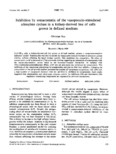论文类型推荐
K+ channel expression in primary cell cultures mediated by vaccinia virus

Abstract A recombinant vaccinia virus (VV) was used to express functional Drosophila Shaker H4 K+ channels in primary cell cultures from rat heart (atrial and ventricular myocytes, fibroblasts), autonomic ganglia (SCG neurons) and CNS (hippocampal neurons, cerebral astroglia). In most cells the expressed currents possessed the typical characteristics of the native Drosophila muscle A currents; a few cells showed evidence of hetero-oligomers with new properties. The maximum current density corresponded to a channel density of 2–3/μm3. Voltage recordings in heart cells showed altered action potential waveforms after successful infection. VV vectors thus are useful for studying altered excitability and cell-specific processing of ion channel proteins.

Somatostatin and α2-adrenergic agonists selectively inhibit vasopressin-induced cyclic AMP accumulation in MDCK cells

Abstract The effect of somatostatin and α2-adrenergic agonists on cyclic AMP accumulation was examined in MDCK cells, grown in denned medium. These hormones inhibited vasopressin-induced cyclic AMP formation, without affecting either the basal or the glucagon- and prostaglandin E2-stimulated level. Pretreating the cells with pertussis toxin, or incubating them with MnCl2 at a low concentration reversed the effect of somatostatin and α2-agonists. These results suggest that somatostatin and norepinephrine could selectively modulate the renal effect of vasopressin, via the inhibitory regulatory subunit (Ni) of adenylate cyclase.

Carbohydrate induced modulation of cell membrane. VI. Binding of exogenous lectin induces susceptibility of erythrocytes to free radical damage: a spin label study

Abstract The oxidation of erythrocyte membrane has been widely used as a model to study the damage of biomembranes by free radicals. Whether binding of lectin to erythrocytes has any effect on peroxidant injury has never been studied. This study reports for the first time that crosslinking of erythrocyte surface glycoprotein by an exogenous lectin significantly enhances the susceptibility to membrane damage by free radicals, as evidenced by the increase in membrane fluidity measured by EPR using spin label and the increase in the amount of oxyhemoglobin liberated due to cell lysis.

Inhibition by somatostatin of the vasopressin-stimulated adenylate cyclase in a kidney-derived line of cells grown in defined medium

Abstract LLC-PK1L cells, a kidney-derived cell line grown in defined medium, possess a vasopressin-sensitive adenylate cyclase. Somatostatin was able to inhibit the vasopressin-induced increase in adenylate cyclase activity, without affecting the basal enzyme activity. This inhibition was competitive. No effect of somatostatin could be detected on [3H]vasopressin binding suggesting an interaction of somatostatin with the vasopressin-sensitive system distal to the hormone—receptor interaction. At variance with N6-L-2-phenylisopropyladenosine (PIA), GTP did not potentiate the inhibition by somatostatin. The inhibition of the vasopressin stimulation by somatostatin and that by PIA were additive. Changing the composition of the cell growth medium increased the number of vasopressin receptors per cell. Cells with a high number of vasopressin receptors were less sensitive to inhibition by somatostatin. Such results suggested that somatostatin and vasopressin receptors and/or the inhibitory (Ni) and stimulatory (Ns) regulatory transducing components are regulated by different mechanisms.

Involvement of poly(ADP-ribose) polymerase and activation of caspase-3-like protease in heat shock-induced apoptosis in tobacco suspension cells

Abstract The cleavage of poly(ADP-ribose) polymerase (PARP) by caspase (casp)-3 is an essential link in the apoptotic pathway in animal cells. In plant cells, however, there is no authentic evidence for the similar role that PARP may play during apoptosis. Using a heat shock (HS)-induced apoptosis system of tobacco cells, we found that immediately after a 4 h heat treatment, PARP was cleaved to form an 89 kDa signature fragment, while DNA laddering appeared only after a 20 h recovery following the HS. An activation of casp-3-like protease was also observed. The results suggest that apoptosis in plants and animals may share common mechanisms. On the other hand, when cells were preincubated with 4 mM 3-aminobenzamide or 2–8 mM nicotinamide, the specific inhibitors of PARP, before HS treatment, apoptotic cell death was reduced significantly. Our results thus imply that PARP may also be involved in apoptosis in a different way from the casp-related events.

Molecular structure of the glibenclamide binding site of the β-cell KATP channel

Abstract We have investigated the structure of the glibenclamide binding site of pancreatic β-cell ATP-sensitive potassium (KATP) channels. KATP channels are a complex of four pore-forming Kir6.2 subunits and four sulfonylurea receptor (SUR1) subunits. SUR1 (ABCC8) belongs to the ATP binding cassette family of proteins and has two nucleotide binding domains (NBD1 and NBD2) and 17 putative transmembrane (TM) sequences. Co-expression in a baculovirus expression system of two parts of SUR1 between NBD1 and TM12 leads to restoration of glibenclamide binding activity, whereas expression of either individual N- or C-terminal part alone gave no glibenclamide binding activity, confirming a bivalent structure of the glibenclamide binding site. By using N-terminally truncated recombinant proteins we have shown that CL3 – the cytosolic loop between TM5 and TM6 – plays a key role in formation of the N-terminal component of the glibenclamide binding site. Analysis of deletion variants of the C-terminal part of SUR1 showed that CL8 – the cytosolic loop between TM15 and TM16 – is the only determinant for the C-terminal component of the glibenclamide binding site. We suggest that in SUR1 in the native KATP channel close proximity of CL3 and CL8 leads to formation of the glibenclamide binding site.

Expression of the T4 molecule (AIDS virus receptor) by human brain-derived cells

Abstract Three human cell lines of astrocytic origin were evaluated for expression of a human T-lymphocyte surface glycoprotein, T4, which also serves as a cellular receptor for the human immunodeficiency virus (AIDS virus, HIV). T4 antigen was detected on the cell surface of 2 of these cell lines using monoclonal OKT-4 antibody and flow cytometry. Gene transcripts encoding the T4 molecule were detected by a ribonuclease protection assay in surface T4-positive and -negative cells. Our results suggest that astrocytes may serve as targets for HIV infection in the brain.

Retinoic acid enhances VIP receptor expression and responsiveness in human neuroblastoma cell, SH-SY5Y

Abstract Retinoic acid (RA) induces partial differentiation of neuroblastoma (NB) cells in vitro. In the human NB line, SH-SY5Y (a neuroblastic subclone of SK-N-SH), RA was previously shown to enhance the stimulatory (PGE1) and inhibitory (opioid) regulation of adenylyl cyclase. Since these cells are also sensitive to cAMP stimulation by vasoactive intestinal peptide (VIP), we have tested the effects of RA on VIP receptor expression and function. Pretreatment of SH-SY5Y cells with 10 μM RA over 6 days dramatically increased VIP receptor number from ∼3 000 to ∼70 000 sites per cell and enhanced threefold the cAMP accumulation after external VIP addition, while VIP immunoreactive content in the cells increased 2–3-fold. In the light of the recently proposed autocrine function of VIP in this cell lineage, the strong enhancement of the VIP system may contribute to the differentiation effects of RA.

Hydroxyl radical-induced apoptosis in human tumor cells is associated with telomere shortening but not telomerase inhibition and caspase activation

Abstract Reactive oxygen species (ROS) have been found to trigger apoptosis in tumor cells. At the same time, telomerase is found to be associated with malignancy and reduced apoptosis. However little is known about the linkage between ROS such as OH and telomerase/telomere. To address the interrelations between OH and telomerase/telomere in tumor cell killing, HeLa, 293 and MW451 cells were induced to undergo apoptosis with OH radicals generated via Fe2+-mediated Fenton reactions (0.1 mM FeSO4 plus 0.3–0.9 mM H2O2) and telomerase activity, telomere length were measured during apoptosis. We found that during OH-induced apoptosis, telomere shortening took place while no changes in telomerase activity were observed. Our results suggest that OH-induced telomere shortening is not through telomerase inhibition but possibly a direct effect of OH on telomeres themselves indicating that telomere shortening but not telomerase inhibition is the primary event during OH-induced apoptosis. Strikingly, we also found that OH-induced apoptosis in HeLa cells is caspase-3-independent but is associated with reduction of mitochondrial transmembrane potential. Our results indicate that OH triggers apoptotic tumor cell death through a telomere-related, caspase-independent pathway.

Characterization of protein kinases in mitotic and meiotic cell extracts

Abstract A number of protein kinases have been separated and identified in extracts from mitotic and interphase culture cells and from mature and immature amphibian oocytes using nondenaturing polyacrylamide gel electrophoresis followed by in situ phosphorylation assays. Certain of these protein kinase activities appear to correlate with the biological activity of extracts, assayed by their ability to induce meiotic maturation following injection into Xenopus oocytes. These results are consistent with the notion that protein phosphorylation/dephosphorylation may be integral to the mechanisms of both nuclear membrane breakdown and chromosome condensation, events common and distinctive to mitosis and meiosis.

点击加载更多












